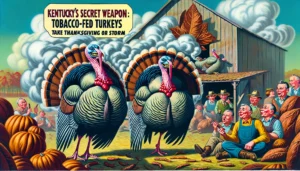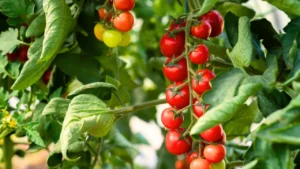Price Controls: The Government’s Favorite Way to Break the Farms (While Trying to Fix Them)
**Somewhere Between Washington D.C. and Reality—**In the never-ending quest to protect the consumer, the government has a time-tested strategy: Price controls. You see, when faced with the complexities of a free market, bureaucrats often believe they can simply dictate prices and, poof, all problems will be solved. This strategy works particularly well when the goal is to break things, especially the fragile ecosystem of American farming.
Price controls are like trying to control a bull with a piece of string—it looks good on paper, but in reality, it’s a mess.
Farmers, bless their hearts, are resilient folks. They’ve weathered droughts, floods, pest invasions, and even the whims of Mother Nature herself. But nothing seems to shake the roots of their operation more than price controls. In a well-meaning attempt to keep food prices low for the average consumer, the government has devised a plan that practically guarantees farmers will suffer, all while consumers still somehow end up paying more in the long run. Let’s dive into the twisted tale of how price controls have turned the farming industry into a cautionary tale of “be careful what you wish for.”
The Great Price Control Disaster: A Field of Broken Promises
Price controls are like the perfect storm of economic ignorance. The concept is simple: The government sets a maximum or minimum price for a product, ensuring that consumers are protected from price gouging or that producers get a fair shake. Sounds lovely, doesn’t it? But here’s where reality sets in: When the government steps in to artificially control prices, it distorts the delicate balance of supply and demand. And on a farm, where the margins are already razor-thin, even the slightest distortion can lead to disaster.
Take the classic case of milk price controls. The government, in its infinite wisdom, decided that the price of milk should be kept low to ensure that everyone can afford their morning bowl of cereal. But what happens when the price farmers receive for their milk doesn’t cover the cost of producing it? You guessed it—they stop producing as much. Less milk on the market leads to shortages, and the quality of milk starts to drop as farmers cut corners to stay afloat.
One dairy farmer, who asked to remain anonymous (probably to avoid the wrath of lactose-intolerant government officials), shared his frustration: “I’m not saying I want to charge a fortune for milk, but when the price the government sets doesn’t even cover my feed costs, it makes me wonder if they’re trying to turn us into an endangered species.”
When the government says, “We’ll handle the pricing,” it’s usually time to brace for impact.
From Bumper Crops to Bumper Cars: A Tale of Agricultural Price Floors
While price ceilings cap how much can be charged for a product, price floors set a minimum price, supposedly to protect producers from selling their goods for too little. On paper, this sounds like a safety net for farmers. But in practice, it often turns into a bungee jump without the cord.
Consider the case of wheat. The government sets a price floor to ensure that farmers receive a minimum price for their crop. Sounds fair, right? Except when that minimum price is higher than what the market would naturally bear, we end up with mountains of unsold wheat. What do you do with a surplus of wheat? If you’re the government, you buy it up and let it rot in warehouses, all while claiming victory for having “protected” the farmer.
One wheat farmer shared his bemusement: “I’ve got enough wheat sitting in storage to feed half the country, but I can’t sell it because the price is too high. The government buys it up, and now I’m basically a wheat hoarder.”
And what happens when the government stops buying the surplus? Well, the farmer is left with a pile of grain and nowhere to go. It’s like being stuck in bumper-to-bumper traffic with no exit in sight.
Nothing says “market efficiency” like the government stepping in to say, “Hey, that price looks too high—let’s make it worse!”
The Black Market Bloom: How Price Controls Sprout New Industries
Where there’s scarcity, there’s opportunity—at least for those willing to work outside the bounds of legality. Price controls, by their very nature, create shortages. When prices are capped too low, demand often exceeds supply, and the result is empty shelves. Enter the black market, where goods can be bought and sold at their true market value—albeit in the shadows.
Take the case of eggs. The government decides that eggs are too expensive, so they impose a price ceiling. Suddenly, eggs are cheap—too cheap for farmers to make a profit. So they stop selling them at the official price and start selling them on the black market instead. Consumers who are willing to pay the real market price can get their eggs, but they have to know the right people (or chickens) to get them.
One local farmer, who now operates his own “free-range” black market, explained: “I never thought I’d be an egg dealer, but here we are. The government says I have to sell my eggs for less than it costs to feed my hens, so I started selling them out of the back of my truck instead.”
And it’s not just eggs. Any product subject to price controls can become a black market commodity, from milk to meat to vegetables. It’s a strange new world where farmers have to choose between going broke and going rogue.
Public Opinion: Between a Rock and a Hard Place
For many consumers, price controls sound like a good idea. After all, who wouldn’t want to pay less for groceries? But as the old saying goes, if it sounds too good to be true, it probably is. While consumers may enjoy lower prices in the short term, they quickly find that price controls come with hidden costs.
One shopper, who used to be a big fan of price controls, shared her change of heart: “At first, I was thrilled that the price of chicken was so low. But then I noticed that the shelves were always empty, and when I could find chicken, it didn’t taste right. Now I’m wondering if it’s worth the savings.”
For farmers, the impact of price controls is even more severe. When the price of their goods is set too low, they can’t cover their costs, leading to financial ruin. Many are forced to sell off their land, abandon farming altogether, or turn to more “creative” ways to make ends meet.
One farmer, who wished to remain anonymous, summed up the situation: “Price controls are like a noose around our necks. They’re supposed to help us, but they’re slowly strangling us instead.”
Expert Insights: The Economics of Price Controls
Economists have long warned about the dangers of price controls, but their voices often go unheard amidst the clamor for quick fixes. The problem with price controls, they argue, is that they distort the natural balance of supply and demand, leading to inefficiencies and unintended consequences.
One economist explained: “Price controls are like trying to force a square peg into a round hole. The market is a complex system that operates on the principles of supply and demand. When you artificially manipulate prices, you disrupt that system, and the results are rarely positive.”
The economist went on to describe how price controls can lead to misallocation of resources. For example, when the price of a product is artificially low, consumers tend to buy more than they need, leading to shortages. At the same time, producers have little incentive to produce more, leading to further scarcity.
“It’s a vicious cycle,” the economist said. “Price controls create scarcity, scarcity leads to higher demand, and higher demand leads to even more scarcity. It’s a downward spiral that’s difficult to escape.”
A History of Failures: Price Controls Through the Ages
Price controls are not a new concept. They have been tried and failed many times throughout history, with predictably disastrous results.
One of the most famous examples of price controls in history is the Roman Empire’s Edict on Maximum Prices. In an attempt to curb inflation, Emperor Diocletian issued a decree setting maximum prices for various goods and services. The result? Widespread shortages, hoarding, and a thriving black market. The edict was eventually abandoned, but not before it caused significant economic damage.
Fast forward to the 20th century, and we see similar stories playing out in the United States and around the world. During World War II, the U.S. government imposed price controls on a wide range of goods, from food to gasoline. While these controls were intended to prevent inflation, they led to widespread shortages and rationing. Consumers had to wait in long lines for basic necessities, and the black market flourished.
More recently, Venezuela’s experiment with price controls has turned into a cautionary tale for the rest of the world. In an attempt to combat hyperinflation, the government imposed strict price controls on basic goods. The result? Empty store shelves, a collapsing economy, and a mass exodus of people fleeing the country in search of food and other necessities.
As one Venezuelan economist put it: “Price controls are the government’s way of declaring war on the market. And in this war, everyone loses.”
Anecdotes from the Front Lines: Farmers Speak Out
For those on the front lines of price controls, the experience is often one of frustration and disillusionment. Take the story of one dairy farmer who found himself caught in the crossfire of government-mandated milk prices.
“I love my cows, and I love producing milk,” the farmer said. “But when the government sets the price so low that I can’t even cover my feed costs, it makes me wonder if it’s worth it. I’ve had to sell off half my herd just to stay afloat, and I’m not sure how much longer I can keep going.”
Another farmer, who grows vegetables, shared a similar story: “The price the government sets for my crops doesn’t even cover the cost of seeds and fertilizer. I’ve had to start selling my produce at the farmers’ market for whatever I can get, just to make ends meet. It’s not ideal, but it’s better than going bankrupt.”
These stories illustrate the real-world impact of price controls on the farming community. While the intention may be to help farmers and consumers, the reality is often far more complex and damaging.
Price controls: because why let farmers make a living when you can create a black market for produce instead?
The Irony of Price Controls: When Helping Hurts
Perhaps the greatest irony of price controls is that they often end up hurting the very people they are intended to help. Consumers may enjoy lower prices in the short term, but they quickly find that those low prices come with hidden costs.
One shopper, who used to support price controls, shared her disillusionment: “I thought price controls were a good idea at first. But now I see that they’ve led to empty shelves, lower quality products, and higher prices in the long run. It’s like a bait-and-switch.”
For farmers, the impact is even more severe. Price controls can lead to financial ruin, forcing them to sell off their land or abandon farming altogether. In the end, the loss of farms and farmers means less food on the market, higher prices for consumers, and a less resilient food supply chain.
As one farmer put it: “Price controls are like a bad harvest. They promise so much but deliver so little. And in the end, we all pay the price.”
Step-by-Step Guides for Surviving Price Controls
For farmers and consumers alike, navigating the world of price controls can be a daunting task. Here are some practical tips for surviving the chaos:
- Pro tips: Stay informed about government policies and how they may impact your business or household.
- Insider knowledge: Diversify your income streams to reduce your dependence on government-controlled prices.
- Expert insights: Build a strong network of suppliers and buyers to help navigate shortages and price fluctuations.
- Best practices: Keep an eye on the black market—sometimes it’s the only place to find what you need (just kidding, sort of).
- Comprehensive coverage: Advocate for policy changes that support free markets and fair prices for both producers and consumers.
For farmers, finding ways to adapt to price controls can mean the difference between survival and bankruptcy. By staying informed and diversifying their operations, they can weather the storm and continue to provide the food and goods that we all depend on.
The only thing growing faster than crops under price controls? Farmers’ frustrations.
Price Controls—The Gift That Keeps on Taking
As we’ve seen, price controls are a well-intentioned but deeply flawed attempt to fix the problems of the market. They promise lower prices and greater access to goods, but in reality, they create scarcity, drive up prices, and hurt the very people they are meant to help.
For farmers, price controls can be a death sentence. They disrupt the delicate balance of supply and demand, making it difficult to cover costs and forcing many to abandon their farms. For consumers, price controls often lead to lower quality products, empty shelves, and higher prices in the long run.
In the end, price controls are a reminder that sometimes, the cure is worse than the disease. And as long as governments continue to believe that they can outsmart the market, we’ll continue to see the same predictable results: chaos, frustration, and economic inefficiency.
Disclaimer
This article is a blend of satire and reality. Any resemblance to actual government policies or price controls is purely coincidental—except for the parts that are depressingly accurate. This is a human collaboration between two beings—one who knows a little too much about economics and one who just wants to buy eggs without going bankrupt.
30 Educational Observations About Price Controls
Originally Published at FarmerCowboy.com
2024-08-16 14:50:41
Karl Hoffman is a distinguished agriculturalist with over four decades of experience in sustainable farming practices. He holds a Ph.D. in Agronomy from Cornell University and has made significant contributions as a professor at Iowa State University. Hoffman’s groundbreaking research on integrated pest management and soil health has revolutionized modern agriculture. As a respected farm journalist, his column “Field Notes with Karl Hoffman” and his blog “The Modern Farmer” provide insightful, practical advice to a global audience. Hoffman’s work with the USDA and the United Nations FAO has enhanced food security worldwide. His awards include the USDA’s Distinguished Service Award and the World Food Prize, reflecting his profound impact on agriculture and sustainability.








Exclusive: Goats start a tech company, innovate in sustainable farming solutions.